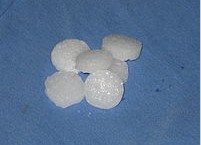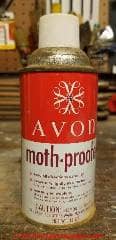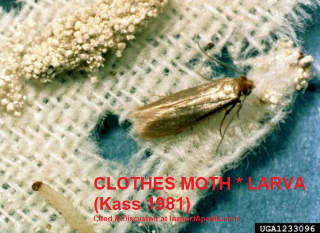 Mothball Odor Impact on Real Estate Sales
Mothball Odor Impact on Real Estate Sales
Persistent mothball smell may deter the sale of homes, condos, etc.
- POST a QUESTION or COMMENT about mothball chemicals, hazards, odors, & odor removal
Mothball or naphthalene odor has been reported to interfere with the sale of homes and condominiums.
Here we describe the problem, suggest both prevention and solution to mothball smells, and we cite research on the effect of smells on the ability to sell a home.
Page top photo, courtesy of Wikipedia commons, shows a cluster mothballs, or a solid form of naphthalene.
InspectAPedia tolerates no conflicts of interest. We have no relationship with advertisers, products, or services discussed at this website.
- Daniel Friedman, Publisher/Editor/Author - See WHO ARE WE?
Mothball & Other Odors' Impact on Real Estate Sales - Naphthalene / Paradichlorobenzene (PDCB)
[Click to enlarge any image]
Naptha fumes from mothballs can both penetrate and be very persistent in carpets, fabrics, even wood and drywall as well as other materials.
Such mothball smells or fumes may pose a respiratory hazard to some people, can be difficult to remove, and can even interfere in the sale of a mothball-smelling property. (New York Times 2017/11/08)
6 Steps to Get Rid of Mothball Smells to Prepare a Property for Sale
If your property smells like mothballs, before tearing the place apart or throwing away furniture or carpets or re-painting,
- Use fresh air ventilation + heat to speed offgassing and dilute odors:
a combination of warm temperatures and plenty of fresh air will speed odor off-gassing from some materials that have absorbed naptha fumes - Identify the primary odor source: it may be a carpet, furnishings, curtains, or stored containers of mothballs.
If the odor is coming from mothballs dumped into a wall or ceiling cavity, professional removal, cleaning, and sealing may be required. But often the odor source is easy to find and remove.
Try this SMELL PATCH TEST to FIND ODOR SOURCE to confirm odor sources in building materials or surfaces - Clean materials & surfaces that can be cleaned,
using any household cleaner; examples are curtains and area rugs that can be professionally cleaned, and clothing that can be laundered or dry-cleaned. - Remove / dispose of materials that can't be cleaned and that have absorbed mothball odors
and that do not quickly off-gas to a sub-sensitive level for the most-sensitive building occupants - it may be necessary to remove carpet and carpet padding; - Paint or seal odor-persistent walls or ceilings (drywall) using an odor-sealant paint such as those used following a building fire.
See example sealant products
at MOLD SANITIZER, SPRAY, BIOCIDE USE GUIDE - See the additional suggestions
at MOTHBALL ODORS - GET RID OF
and
at ODORS GASES SMELLS, DIAGNOSIS & CURE - home
Research on Mothball Odor Impact on Selling Real Estate
- Anstine, Jeff. "Property values in a low populated area when dual noxious facilities are present." Growth and Change 34, no. 3 (2003): 345-358.
- Ayoko, Godwin A., and Erik Uhde. Organic compounds adsorbed on particles and settled house dust. Wiley-VCH: Weinheim, 2003.
- Boyle, M., & Kiel, K. (2001). A survey of house price hedonic studies of the impact of environmental externalities. Journal of real estate literature, 9(2), 117-144.
- Kaysen, Ronda, "Failing the Sniff Test: The Apartment Looks Fantastic, but What Is That Smell in the Hall?", The New York Times, Ask Real Estate, 2017/10/29 p. 14
Paraphrasing: prospective buyers of a New York City apartment on the Upper West Side notice a strong camphor smell flooding the hallway ... a [resident] uses mothballs [apparently to excess].
The real estate advisor quoted Daniela Sassoun, an associate broker at Douglas Ellman, citing possible health and mothball odor complaints, advised the buyer to look elsewhere, stating "Walk away, ... Even if it's a great apartment, it's just not worth it.".
- Kiel, Katherine A. "Measuring the impact of the discovery and cleaning of identified hazardous waste sites on house values." Land Economics (1995): 428-435.
- McClelland, Gary H., William D. Schulze, and Brian Hurd. "The effect of risk beliefs on property values: A case study of a hazardous waste site." Risk analysis 10, no. 4 (1990): 485-497.
Abstract:
Health risk beliefs of homeowners near a landfill site were assessed in a survey and compared to expert judgments of the health risks of living near the site. A bimodal distribution of health risk beliefs suggested sharp disagreement between the experts and at least some of the residents.
Correlates of high risk beliefs included perception of odor from the site, exposure to media coverage of the problem, having children living at home, age (younger respondents more concerned), and gender (females more concerned).
An aggregated neighborhood health risk belief predicted reductions in home prices even after controlling for home physical characteristics, such as size and other disamenities such as proximity to a freeway.
In the 4100 homes near the site, the estimated depression in property values was estimated to total about $40.2 million before the site was closed and to be about $19.7 million after closure. Implications of these results for community conflict and for benefit-cost analysis of hazard site remediation are discussed. - [4] McGinley, Charles M. P.E., Michael A. McGinley, MHS, Donna L. McGinley, " “Odor Basics”, Understanding and Using Odor Testing", paper presentation, The 22nd Annual Hawaii Water Environment Association Conference., Honolulu, Hawaii: 6-7 June 2000, St. Croix Sensory Inc. / McGinley Associates, P.A. 13701 - 30th Street Circle North Stillwater, MN 55082 U.S.A. 800-879-9231 stcroix@fivesenses.com, retrieved 9/22/12, original source http://www.fivesenses.com/Documents/Library/33%20 %20Odor%20Basics.pdf, [copy on file as Odor_Basics.pdf]
- Palmquist, Raymond B., Fritz M. Roka, and Tomislav Vukina. "Hog operations, environmental effects, and residential property values." Land Economics (1997): 114-124.
- Reichert, Alan, Michael Small, and Sunil Mohanty. "The impact of landfills on residential property values." Journal of Real Estate Research 7, no. 3 (1992): 297-314.
- Sims, Sally, Peter Dent, and G. Reza Oskrochi. "Modelling the impact of wind farms on house prices in the UK." International Journal of Strategic Property Management 12, no. 4 (2008): 251-269.
- Tennakone, K., and M. G. C. Peiris. "Sublimation of moth balls." American Journal of Physics 46, no. 4 (1978): 418-419.
Abstract: The study of the decay of a moth ball due to sublimation is an instructive exercise in physics which demonstrates diffusion phenomena.
The rate at which a moth ball exposed to the atmosphere wears away due to sublimation is calculated. Experiments are given to demonstrate the validity of the calculation. - Timm, Robert M. "House mice." (1994).
- Van Winkle MR, Scheff PA. Volatile organic compounds, polycyclic aromatic hydrocarbons and elements in the air of ten urban homes. Indoor Air. 2001;11:49–64.
...
Reader Comments, Questions & Answers About The Article Above
Below you will find questions and answers previously posted on this page at its page bottom reader comment box.
Reader Q&A - also see RECOMMENDED ARTICLES & FAQs
On 2021-01-10 - by (mod) - mothball odors persist in carpet.
Jake,
If the carpet is valuable, you might try having it temporarily removed for professional cleaning and you might replace the padding below.
You should also be sure to do a smell patch test as we described in this article Series so that you're confident that the carpet or its padding are the actual odor source and not other building surfaces or contents.
On 2021-01-09 by Jake
I can’t get mothball smell out of carpet. I think the odor is trapped under the pad. I’ve tried ventilation, heat, vacuums and steam cleaning. The smell always returns. Should I have the carpet replaced? The sunlight can’t reach that part of carpet.
On 2019-09-18 - by (mod) - mothball odors persist in crawl space
Paula
To offer a useful suggestion I"d need to know more about the construction, crawl space access, space therein and more.
Depending on how far you threw the mothballs you might be able to use a shop vac to pick them up.
Follow that by ventilating the crawl area, perhaps boosting air flow by fans.
On 2019-09-18 by Paula
I threw loose mothballs in a large crawlspace filled with dirt and large rocks with on open side to my basement which is used all the time. I then realized it is dangerous to breath. I can't get in the area how do I get rid of the smell and fumes?
...
Continue reading at GET RID of MOTHBALL ODORS - or select a topic from the closely-related articles below, or see the complete ARTICLE INDEX.
Or see these
Recommended Articles
- MOTHS, MOTHBALL ODORS - home
- HEALTH EFFECTS of EXPOSURE to MOTHBALLS
- REDUCE INDOOR EXPOSURE to MOTHBALL CHEMICALS
- GET RID of MOTHBALL ODORS
- LIFE EXPECTANCY of MOTHBALLS
- MOTHBALL ODOR IMPACT on REAL ESTATE SALES
- TERMITES & NAPHTHALENE HAZARDS
- NAPHTHALENE POISONING SYMPTOMS
- NAPHTHALENE HEALTH HAZARD RESEARCH
- NAPHTHALENE / PARABENTIOL OFF-GAS TESTING
- ODORS GASES SMELLS, DIAGNOSIS & CURE - home
- OZONE AIR PURIFIER WARNINGS
- PESTICIDE EXPOSURE HAZARDS
- SMELL PATCH TEST to FIND ODOR SOURCE
- TERMITES & NAPHTHALENE HAZARDS - that mothball smell might not be from mothballs!
Suggested citation for this web page
MOTHBALL ODOR IMPACT on REAL ESTATE SALES at InspectApedia.com - online encyclopedia of building & environmental inspection, testing, diagnosis, repair, & problem prevention advice.
Or see this
INDEX to RELATED ARTICLES: ARTICLE INDEX to BUILDING ODOR DIAGNOSIS & CURE
Or use the SEARCH BOX found below to Ask a Question or Search InspectApedia
Or see
INDEX to RELATED ARTICLES: ARTICLE INDEX to INSECT DAMAGE
Or use the SEARCH BOX found below to Ask a Question or Search InspectApedia
Ask a Question or Search InspectApedia
Try the search box just below, or if you prefer, post a question or comment in the Comments box below and we will respond promptly.
Search the InspectApedia website
Note: appearance of your Comment below may be delayed: if your comment contains an image, photograph, web link, or text that looks to the software as if it might be a web link, your posting will appear after it has been approved by a moderator. Apologies for the delay.
Only one image can be added per comment but you can post as many comments, and therefore images, as you like.
You will not receive a notification when a response to your question has been posted.
Please bookmark this page to make it easy for you to check back for our response.
IF above you see "Comment Form is loading comments..." then COMMENT BOX - countable.ca / bawkbox.com IS NOT WORKING.
In any case you are welcome to send an email directly to us at InspectApedia.com at editor@inspectApedia.com
We'll reply to you directly. Please help us help you by noting, in your email, the URL of the InspectApedia page where you wanted to comment.
Citations & References
In addition to any citations in the article above, a full list is available on request.
- In addition to citations & references found in this article, see the research citations given at the end of the related articles found at our suggested
CONTINUE READING or RECOMMENDED ARTICLES.
- Carson, Dunlop & Associates Ltd., 120 Carlton Street Suite 407, Toronto ON M5A 4K2. Tel: (416) 964-9415 1-800-268-7070 Email: info@carsondunlop.com. Alan Carson is a past president of ASHI, the American Society of Home Inspectors.
Thanks to Alan Carson and Bob Dunlop, for permission for InspectAPedia to use text excerpts from The HOME REFERENCE BOOK - the Encyclopedia of Homes and to use illustrations from The ILLUSTRATED HOME .
Carson Dunlop Associates provides extensive home inspection education and report writing material. In gratitude we provide links to tsome Carson Dunlop Associates products and services.





